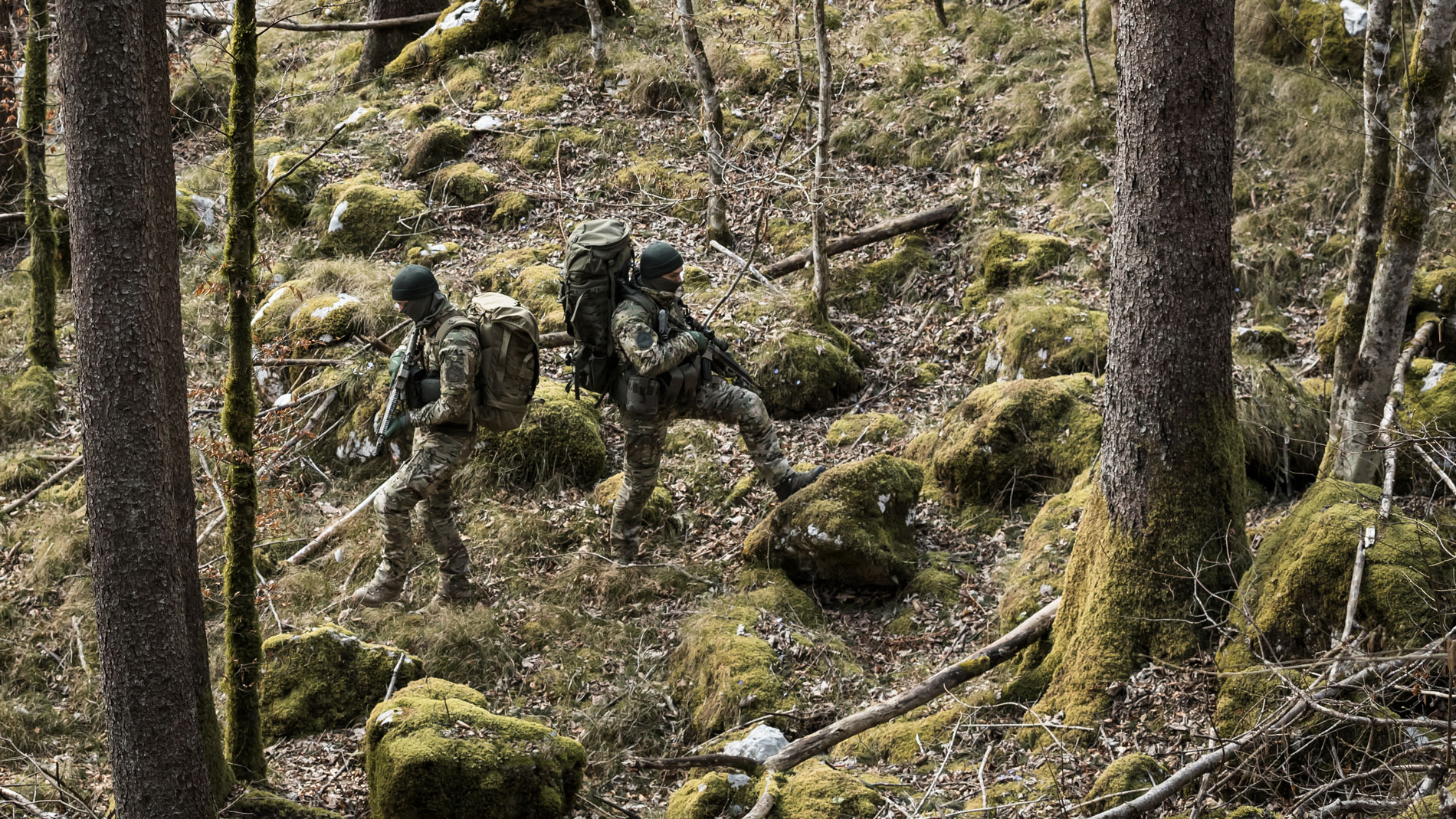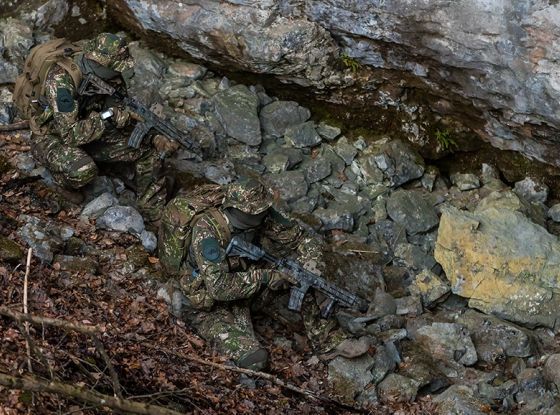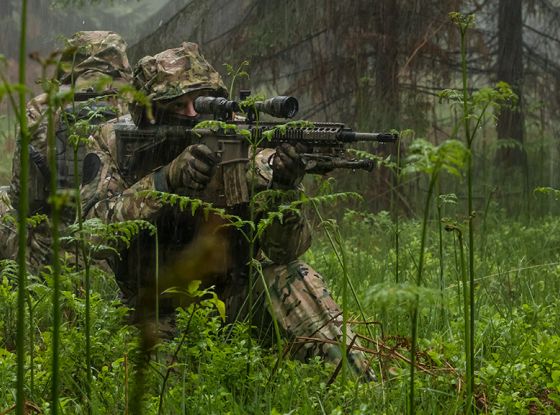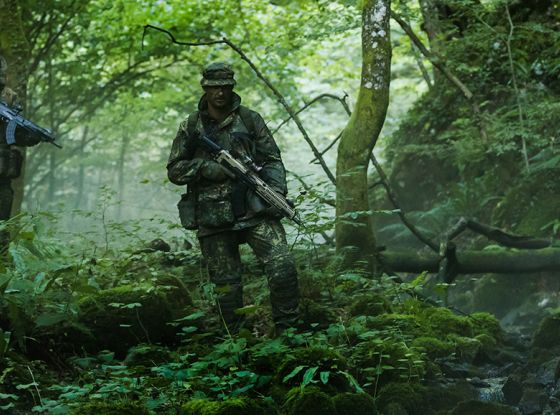Modern military camouflage works because it is based on well-founded science. After recounting some of the history of military camo, this post proceeds to discuss the laws of physics and physiology that undergird modern concealment methods and materials.
In this blog post:
There are various ways by which soldiers can disguise themselves to either avoid an encounter with hostile forces or gain over them the element of surprise. The least effective disguise is a fake mustache. But among the very most effective disguises is camouflage, the purpose of which is to make soldiers and equipment less visible to enemy eyes.
Traditionally, camouflage is a pattern-and-colour design formulation intended to make soldiers and equipment less visible to enemy eyes. As you’ll come to appreciate by reading this post, modern military camouflage works as well as it does because it is based on long-settled scientific precepts. Indeed, the science at this point is millenia old, but it is really only in the last hundred years that camouflage producers acquired the deep understanding of the laws of physics and physiology that permit the remarkable array of camo patterns and camo colours now available to military forces around the world.
In an earlier post, we discussed the different types of camouflage. In a separate post, we touched on the differences between hunting camo patterns and those for military use. In this post, we’ll focus on the visual differences and inherent properties of the patterns.
To recap, camouflage is designed for a specific environment or task. We can further split areas of effect into two subcategories, the first being visual, the other non-visual.
Let’s take a look now at military camouflage (or concealment tech, as it’s better known nowadays). It’s not like the camouflage you might wear in the civilian world as a hunter or as someone trying to be “tacticool.” But what is it that makes military camouflage “military?” And just how ingeniously different from civilian camouflage must it be to achieve effectiveness on today’s battlefields?
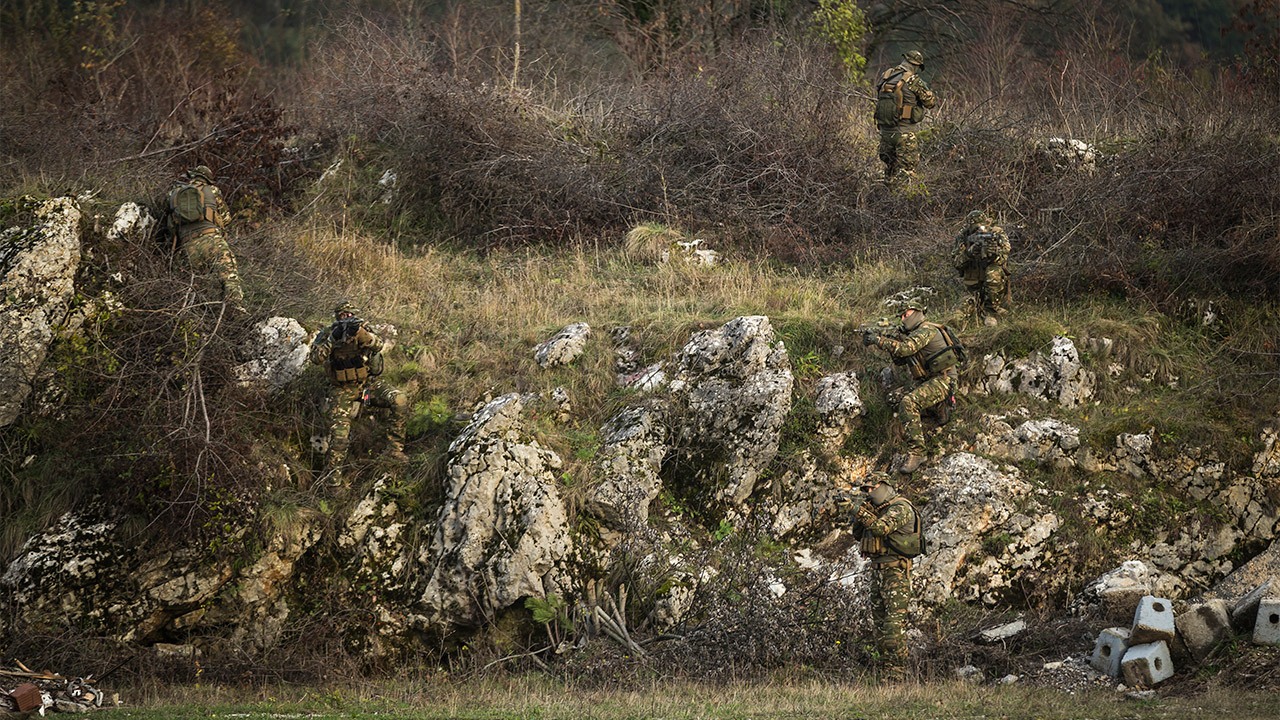
What is military camouflage?
Military camouflage is any material or means that can be used by armed forces to make it harder or, ideally, impossible to be seen at a distance by an opposing armed force before or during a tactical operation.
Military camouflage is different from others in the sense that the theatres and the detection methods change from natural to man-made, thus shifting from conventional patterns to the multispectral holy grail of which we all dream.
Where does camouflage come from?
The word camouflage is of French origin (the actual word is camoufler) and the idea it conveys is that of taking something visible and rendering it invisible by making it look like something other than what it actually is.
For example, let’s say you have an armoured vehicle parked next to a grove of trees. With the right camoufler, you could make the vehicle look from a distance a lot less like a vehicle and much more like a piece of the grove.
Oh, wait. When you ask “Where does camouflage come from?” you don’t mean etymologically. You mean industrially. Well, the type of camouflage made for wear by soldiers comes from textile mills and other raw-materials producers that manufacture camouflaged fabrics for sale by the bolt to garment makers like us. The camo patterns and camo colors are typically screen printed or dye sublimated onto the fabric before the clothing is stitched together.
Fooling the enemy
Before proceeding further with our discussion of military camouflage, we need to clarify what camouflage actually is.
Military Camouflage has a codename, MILDEC (short for “military deception”), which means it’s not just a type of material or piece of equipment but also a strategy. In this instance, the strategy of which we speak is one employed to gain advantages in a theatre of war (or in multiple theatres).
At its most basic, then, camouflage is any material designed to fool an enemy’s eyes into not seeing you, your equipment, or your hiding place.
If you need to conceal your position, camouflage is the right tool for the job.
If you need to go undetected just long enough to successfully spring an ambush on the enemy, again camouflage is the answer.
And if you need to slip past the enemy without them ever knowing you were in proximity, cloaking yourself in camouflage will help you reach the relative safety of your own lines.
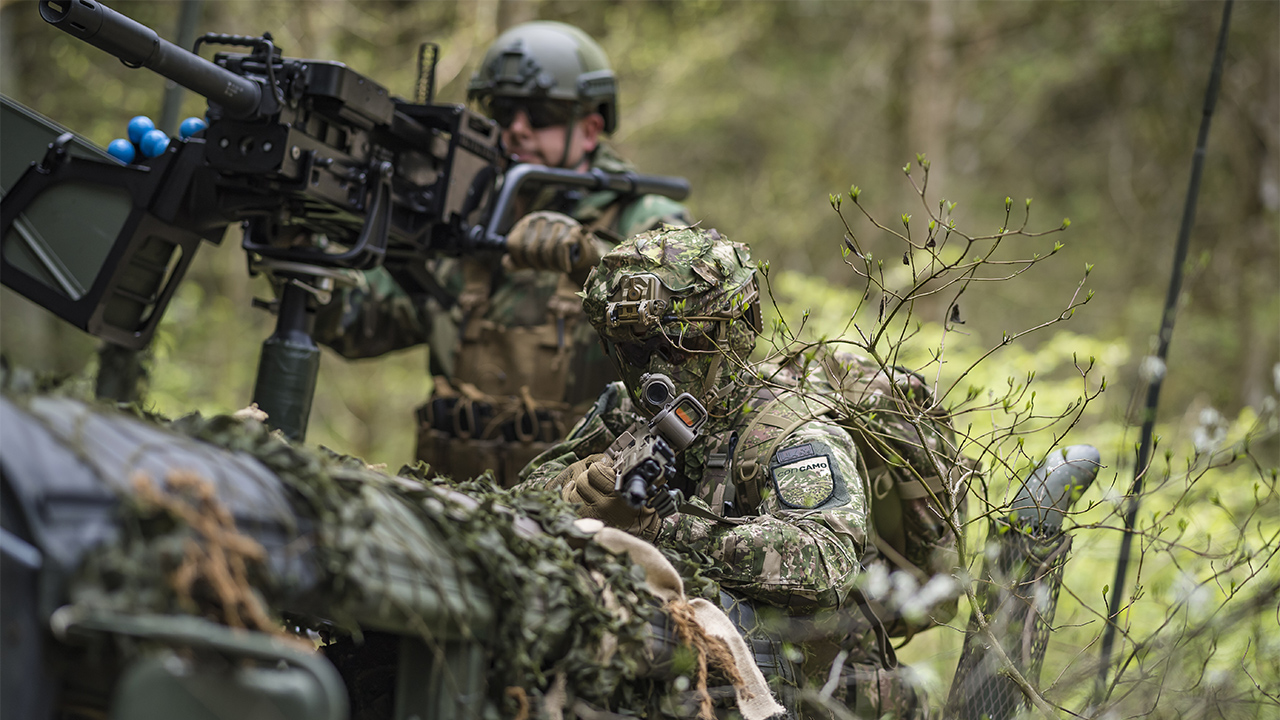
Useful for both offense and defense
In any offensive or defensive situation where you must visually trick the enemy in order to achieve a particular objective, camouflage is absolutely essential. The right camouflage for the environment in which you’re operating can prevent the enemy from figuring out what you’re doing until it’s too late to counter your move.
Once upon a time, the way that troops, equipment, and structures were concealed required use of natural materials. For example, to cloak an armoured vehicle, you might drape it with the branches of trees. To hide yourself, you might tie onto your solid olive-drab uniform sheaths of tall grass.
Not any more. Nowadays, camouflage elements are the products of advanced technologies that are painted on, printed over, or woven in.
The science behind camouflage
Historical accounts of great military deceptions are legion. Among the best known is the Trojan Horse gambit. You remember it (even though it happened centuries before you were born): ancient Greece was at war with the walled city-state of Troy. For 10 years, the Greeks laid siege to easily defended Troy and were stalemated at every turn.
Tired of this, the Greeks eventually came up with a sneaky scheme to penetrate the heavily fortified walls and overthrow the city. Step One, the Greeks pulled back as if to say “We quit.” Step Two, the apparently withdrawing Greeks then left behind a giant wooden horse on wheels to honor the city’s heroic defenders. The Trojans cheered as the “gift” was wheeled inside the gates, unaware that concealed within the belly of the beast was a squad of elite Greek commandos.
That night, after the city was fast asleep, the commandos cracked the secret hatch built into the horse and slipped out to begin stealthily making their way to Troy’s gates. Upon reaching their objective, the squad opened the gates to allow a waiting phalanx of Greek archers, charioteers, and assorted foot soldiers to storm in and conquer the place (read about it in the literary classic Iliad and Odyssey, written in approximately 750 B.C.).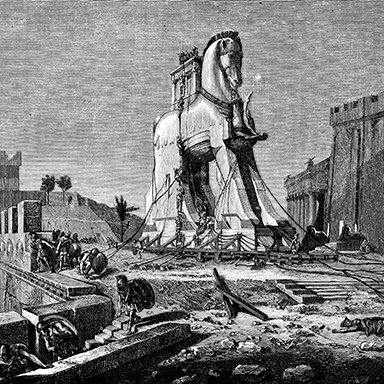
Trojan Horse-style deception was a concept discussed in The Art of War by ancient Chinese military strategist Sun Tzu. He enthusiastically endorsed it in the context of ways to secure victory despite being outnumbered by the enemy.
There are countless other citable examples of deception throughout military history. However, to get directly to the point, deception has been long recognised as an effective means of shifting the tide of battle.
Among the deception doctrines embraced by the U.S. military and its allies are three notable precepts.
Magruder's Principle
According to this axiom, it is generally easier to induce a target to maintain a pre-existing belief than it is to deceive him for the purpose of changing his belief.
Magruder’s Principle was first employed during Operation Mincemeat, a British ploy to disguise the 1943 Allied invasion of Sicily.
Jones' Dilemma
Jones’ Dilemma states that deception becomes more difficult as the number of channels of information available to the target increases, but also that the greater the number of controlled channels the greater the likelihood the deception will be believed.
This was demonstrated during Operation Bodyguard ahead of D-Day—the allies pumped out tonnes of misleading intel to convince the Germans that the 6 June 1944 invasion would take place not at Normandy but far away up the French coast.
Windfall avoidance
According to the principle of avoiding windfalls, deceptive intel is less likely to be believed the easier it’s obtained.
A little bit like today’s get rich quick schemes, they’re just too good to be true.
MILDECs today
You might be curious to know what operational MILDECs currently embody. The table below will clue you in.
Looking closely at that table, you might notice that there are two standout dimensions of deception. They are length of effect (shown in the vertical axis) and type of effort required to implement the method (shown along the horisontal axis).
Most relevant to our discussion are the matters of concealment and camouflage. Are they different from one another? If so, how?
Concealment describes the hiding of assets (i.e. people, vehicles, and equipment) by use of vegetation, tarps, and other means that prevent detection of the assets’ distinctive shapes.
Camouflage refers to the use of different shapes, materials, colours, and illumination to prevent detection of assets while they are on the move. Also, camouflage is formally deemed a MILDEC subset because of its emphasis on deception.
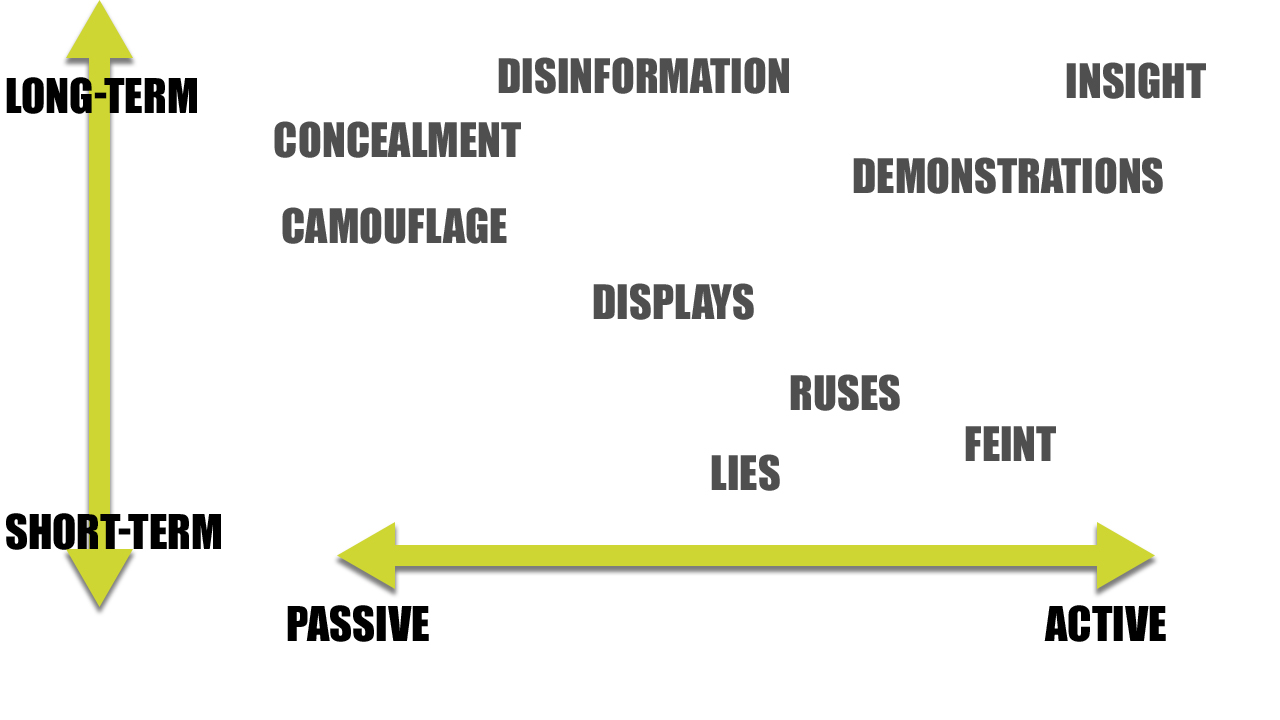
Camouflage and tactical clothing
When it comes to tactical clothing, the colour and pattern of the selected camouflage must match the environment in which the garment will be worn. Failure to achieve a proper match will almost surely result in subpar performance.
In worst-case scenarios, the wrong colour and pattern could potentially make you more visible rather than less.
Ideally, if the colour and pattern align with the environment, you should be capable of positioning yourself a short distance from your objective and very likely remain there, lying in wait or conducting surveillance, for days at a stretch without being detected.
Unfortunately, no camouflage is really ever a perfect match for your theatre’s environment. The places you pass through during the course of a mission can vary in geometry and colour composition a little or a lot every half-kilometer in some cases.
So the camouflage that was effective at the start of the mission might become less effective the farther you advance into the environment. Of course, the reverse could just as easily be true with the camouflage gaining effectiveness as you progress and rack up the kilometers.
How camouflage works
The basic principles of visual camouflage are:
Resemblance to surroundings
Disruptive colouration
Eliminating shadow
Distraction
Self-decoration
Countershading
When you closely examine military camouflage, the first thing you’ll likely notice is its pattern. Camouflage patterns are made of assorted colours and shapes of different sizes. These serve as the building blocks of concealment.
Humans are hardwired to notice these building blocks no matter whether the pattern embraces a digital, pixelated, lizard-style, disruptive, universal, or other type of camouflage scheme. The underlying principles of camouflage leverage this hardwiring in order to effectively achieve concealment.
Important to note as well is the fact that, in humans, the range of visible light is relatively short compared to the totality of wavelengths comprising the electromagnetic spectrum. For humans, visible light occupies the narrow spectral band of approximately 0.4 to 0.7 microns. Situated to one side of visible light is the invisible ultraviolet band and to the other is the equally invisible infrared band (for the record, the heat produced by your body is thermal radiation and it too is an invisible band, existing at the 10-micron slot along the electromagnetic spectrum).
We mentioned the visual principles of most common camouflage types here. A breakdown of the digital patterns of MultiCam can be found in this post. We also compared MultiCam to Scorpion W2 here.

Above: an illustration depicting the electromagnetic spectrum. Image source: wikipedia.com
The fundamentals of camouflage
There are three basic elements to camouflage: environmental mimicry, colour replication, and eye-brain signal interference.
Environmental mimicry
Let’s say you’re standing in front of a tree. To conceal yourself from an enemy intent on spotting you, you could simply step behind the tree. While that would prevent detection by your foe, the problem with hiding behind a tree is it costs you the ability to surveil the enemy for however long you remain in that position.
Contrarily, the easiest way to maintain eyes on the bad guys is to continue standing in front of the tree. However, you won’t be easily seen there if the camouflage you’re wearing consists of variously-sized and shaded shapes that, from a distance, look identical to those of the tree’s bark, branches, and leaves. That’s what environmental mimicry is all about: the use of two-dimensional geometric objects arrayed in a specific pattern to imitate the three-dimensionality of the surroundings in which you are or will be operating.
Colour replication
It’s not enough to mimic the shapes of the environment. Camouflage must also accurately depict the locality’s colours. For example, even if the shapes perfectly imitate those of a tree, that won’t matter if the tree is a blend of brown, green, and black but the predominant colour of the camouflage is tan. Consequently, it is vital that the camouflage correctly replicate the colours encountered in your theatre of operations.
Eye-brain signal interference
As enemy eyes search for you, the pictures produced by those optical organs are fed to the brain where they undergo a process of interpretation. Without camouflage, the enemy’s brain will readily recognise your distant outline or silhouette as that of a human and not that of, say, a tree. By the opposite token, with camouflage your body won’t be easily recognised for what it is because the brain is prevented from properly interpreting information uploaded from the eyes. However, eye-brain signal disruption is most pronounced when environmental mimicry and colour replication are optimised.
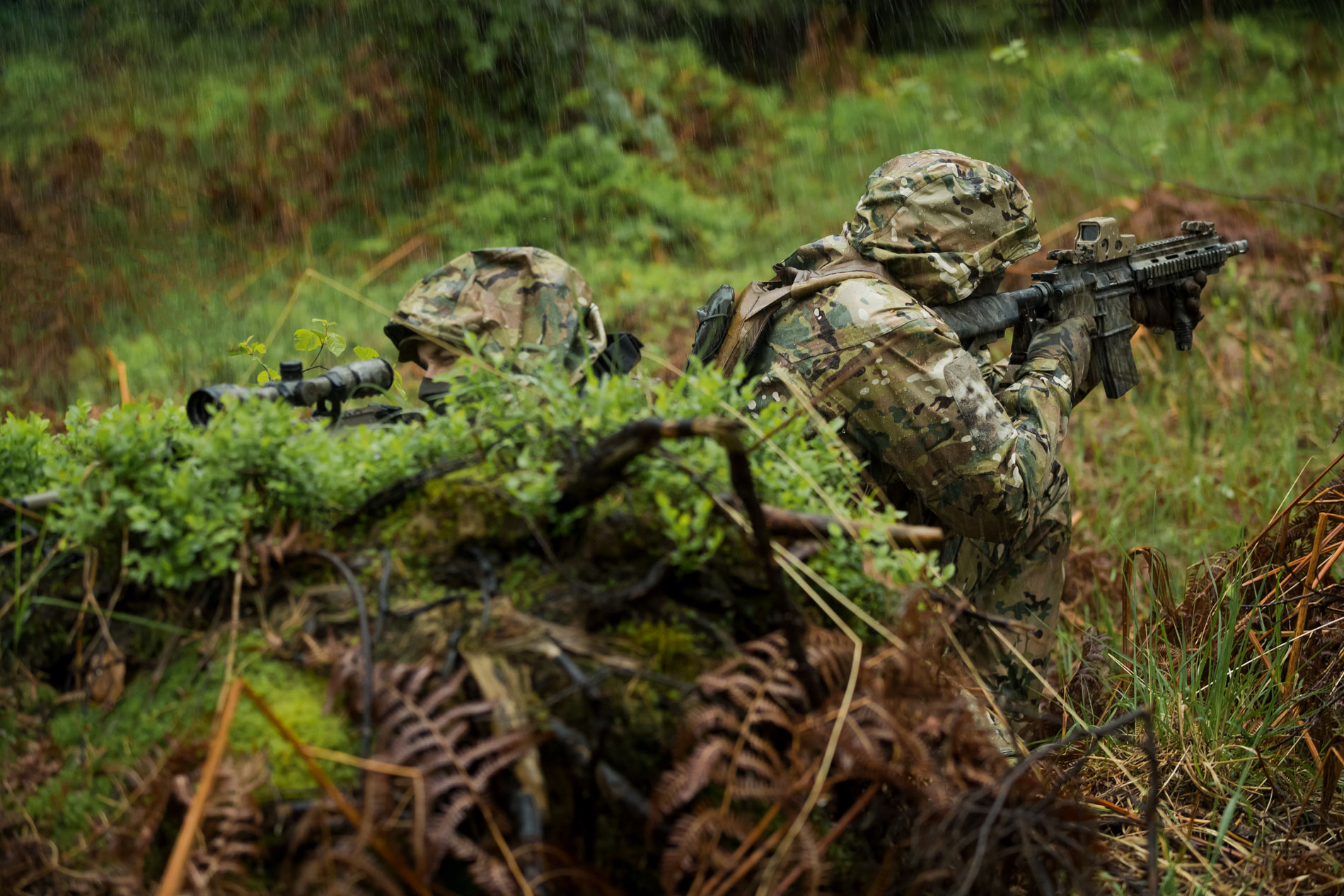
Camouflage Methods
You can use camouflage to do basically three things: vanish from sight, blend into your surroundings, or make yourself look like something you’re not.
Vanishing
There will be times when you need to hide and avoid leaving even so much as a hint of your presence. Success in this regard requires maximum use of concealment materials above and beyond those you might be wearing as part of your uniform. An example would be digging a deep, wide hidey-hole and then affixing atop the lid you fashion to cover it an array of grasses, leaves, and twigs collected from the immediate vicinity.
Blending
Camouflage done right can allow you to appear as if you’re part of the environment the same way many birds and animals do in their natural setting. Blending is especially useful when your task is to observe the enemy from a stationary position (it’s far easier to blend in while motionless than it is to blend in while on the move).
Deceiving
Camouflage can be used to convince the enemy to make disastrous decisions. For instance, suppose you wanted to lure a small squad of bad guys into a trap by misdirecting them away from the place of safety to which they’re headed. One way you might accomplish this is by dressing up, “scarecrow” style, a dozen or so tall shrubs on the path ahead of the enemy squad (you’d attire those bushes in impossible-to-not-see solid-colour uniforms and helmets).
What might transpire next is the hostiles will spot the attired shrubs from a distance and mistakenly believe a losing encounter with a superior “force” awaits if they continue onward. This might convince the bad guys to change direction in order to avoid that fight. Unfortunately for them, the new course they set out upon takes them right into your midsts, where you’ve been waiting in ambush. In this example, it’s not just you who is camouflaged but also the environment in order to pull off the deception.
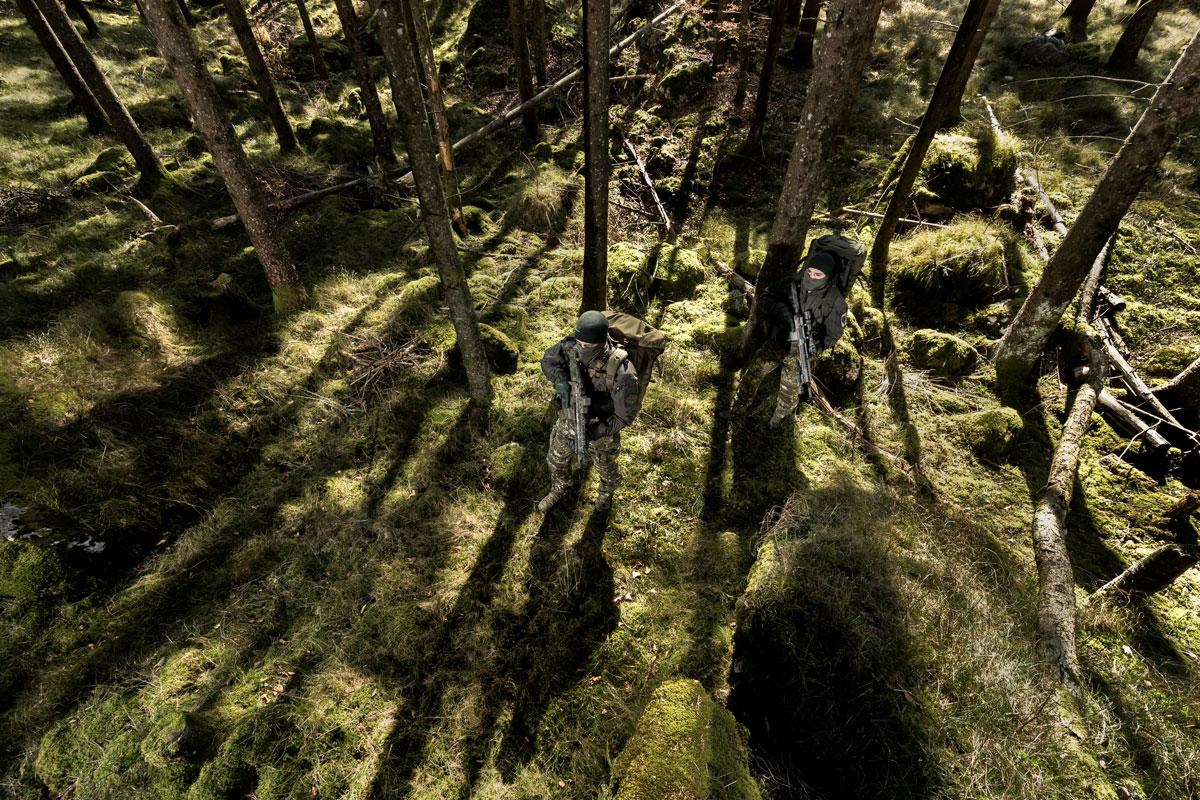
Seeing through camouflage
When you look at any camouflage material, what you’re actually seeing are visible wavelengths of light captured by your eye and interpreted by your brain. But with camouflage, the whole idea is to cause your brain to misinterpret the wavelength signals supplied by your eyes.
The evolution of camouflage has been such that concealment materials are now really good at causing misinterpretation by the brain. So effective are they in fact that it became necessary to develop countermeasures in the form of technology capable of seeing through camouflage.
These countermeasures work by detecting non-visual wavelengths of light.
Lightwaves you can’t see
On the electromagnetic spectrum of non-visual light are (as mentioned above) the infrared wavelengths. Devices capable of picking up these wavelengths permit users to see in the dark. For example, if the enemy is using night-vision goggles, you’ll stand out like a sore thumb if you’re wearing conventional camouflage.
Elsewhere on the spectrum (again as briefly discussed earlier) is non-visible ultraviolet light. Sensors designed to detect ultraviolet rays bouncing off a camouflaged human body can compare them to the rays bouncing off everything else in the immediate vicinity in order to render an image of that body. This tech is especially effective against you if it’s a bright, sunny day and you’re standing in a field of freshly fallen snow or amidst a patch of white sand.
Also referenced above is the fact that heat is another form of non-visible light. It too can be harnessed to see through camouflage. The thermal-sensing technology that performs the seeing detects the temperature of objects and then produces images of them based on variations of the collected readings. For example, if the sensor observes a temperature region of 37 degrees Celsius (98.6 degrees Fahrenheit) that measures approximately 170 centimeters tall and 15 centimeters wide surrounded by a second much larger temperature region of 21 degrees Celsius (70 degrees Fahrenheit), it will generate an image showing what appears to be an adult male next to a bunch of trees.
Lastly, there are the radio wavelengths. These can be used to spot objects by pinging them with transmitted signals. That’s how radar works. You aim a radio wave, it strikes an object in its path, the wave bounces off that object, and returns to the source of the transmission where sophisticated equipment evaluates the characteristics of the returned wave and offers an interpretation. Radar technology today can tell whether the object it pinged is man or machine.
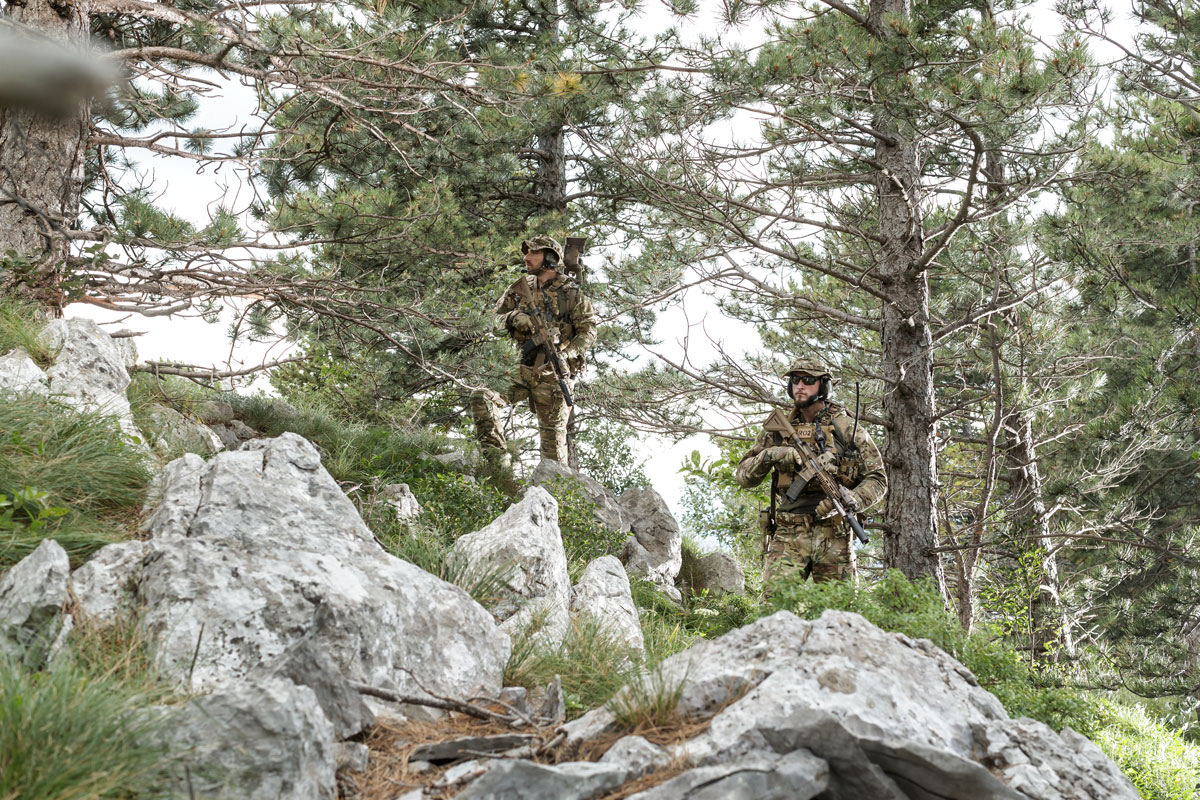
No place to hide?
These technologies that can see past your camouflage are quite formidable but can be thwarted to some extent. Unfortunately, you can’t succeed with a mere change of camouflage pattern. To counter these technologies, you need to fight fire with fire (or, more properly, you need to fight technology with better technology).
Accordingly, military scientists have been working hard to develop garments made with materials that minimise the discharge of body heat in order to foil the enemy’s thermal-sensing devices.
Military scientists have also been striving to translate from theory to practical application a range of devices that conceal troops and vehicles from infrared and radar detection.
The cherry atop this cake is smart camouflage. This is clothing overlayed with microprocessors that permit the camouflage with which you begin the mission to change into a different pattern as you traverse from one environment to the next. The kicker is that the pattern changes automatically based on inputs collected by sensors affixed to the clothing.
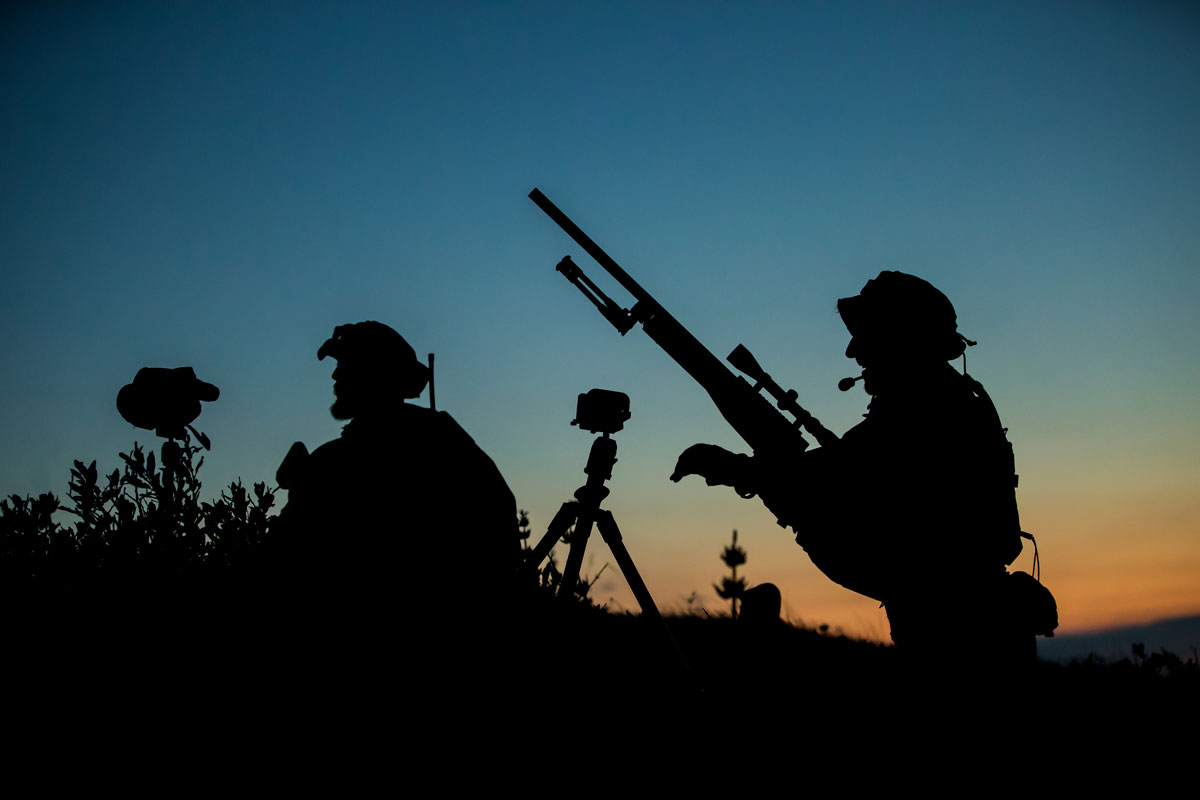
Non-visual camouflage methods
The principle of “resemblance to the surroundings” is similar to the visual spectrum. However, here the detection methods change to a different specialized device.
Near-infrared spectrum concealment
We’re often asked whether camouflage patterns we offer are “NIR.” This is a question that would seem to require only a simple “yes” or “no” answer. But dive a bit deeper and dissect the question more thoroughly and you’ll see there is more knowledge to be uncovered than meets the eye (pun intended).
Adjacent to the visible red band of light on the electromagnetic spectrum is the infrared wavelength (0.75 to 1.0 microns). The portion of the infrared band closest to the visible red band is known as near-infrared (NIR). In layman’s terms, NIR is a lower-energy electromagnetic wave. You can’t see it, but detection technology can.
Camouflage patterns do not affect the ability of an NIR detector to see camo material. The reason is that the detector senses not the properties of the material but rather the NIR signal emitted by the fabric’s coatings and/or dyes.
Yhis is a point proven by HyperStealth's brilliant article about the United States Phase VI Baseline patterns.
Using the same visual pattern (MARPAT), dramatically different results are achievable with night-vision optics.
Military equipment can have good NIR performance only if it emits less light in the near-infrared spectrum.
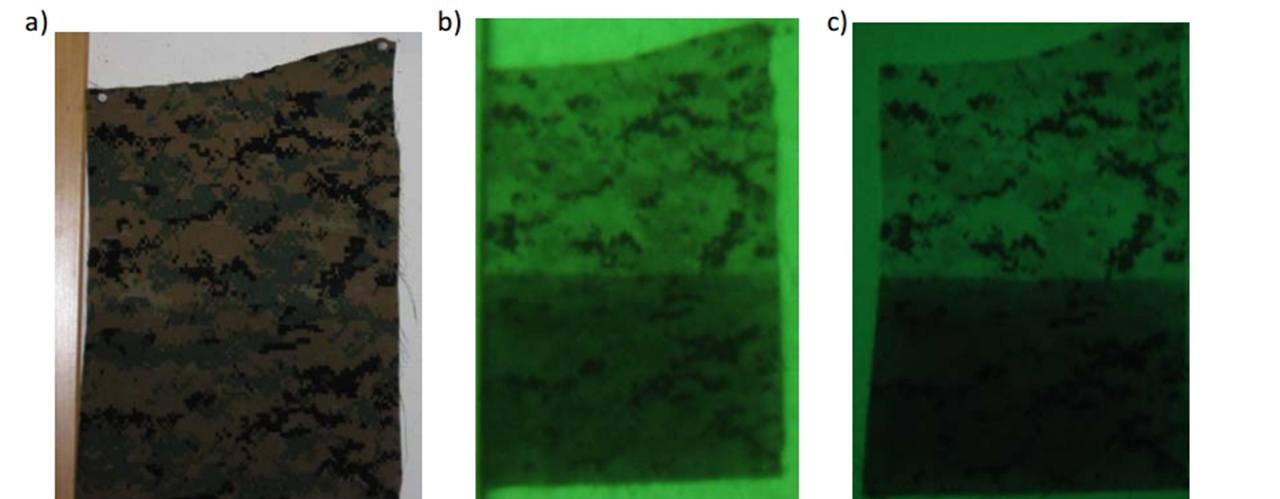
Image source: hyperstealth.com
Radar Concealment
When you think about radar, don’t get hung up on the notion that its only use is the tracking of surface vehicles and aircraft or maybe aerial reconnaissance. It can just as easily identify and track people on the ground.
Accordingly, the advent of the modern battlefield in the 20th Century and the introduction of MSTAR-type portable radar have made it imperative that the fabrics used in military camouflage be able to prevent radio wave detection of troops.
In 2007, Milliken and Co. published a patent under the name “radar camouflage fabric.” The patent application describes the new material as combining a base layer with a conductive layer to significantly reduce the risk of detection by microwave sensors (specifically, those emitting microwaves in the same frequency band for long-range radar systems). The patent was approved in 2011.
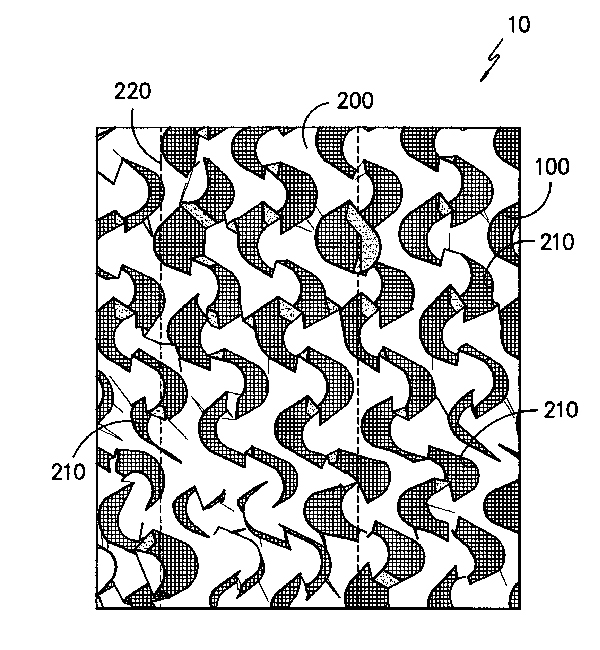
Image source: Google patents
Thermal concealment
Arguably, the pièce de résistance in stealth technology is thermal-imaging concealment.
Let’s do a thought experiment to illustrate just how different a beast thermal-imaging concealment is compared to these other technologies. Say you’ve got a buddy who wants to explain to you why every other brand except UF PRO military camouflage pants are the best on the market. Assume also you’re trying to hide from this guy because you know that what he’s going to say is ridiculous, since UF PRO pants are indeed the best. You’re hiding in complete darkness but you make the mistake of wearing a bright white shirt. This shirt will be instantly detectable if even the slightest amount of light shines on it. So you lay on the ground and cover yourself with a dark fleece fabric. As a result, your buddy is going to have a hard time spotting your white shirt—and will be denied his ability to spout that totally wrong opinion about UF PRO pants.
But now let’s alter things a bit by revealing that your buddy isn’t one to give up easily. So he equips himself with a special see-through camera that lets him instantly detect in a 100-meter radius anything coloured white. Now your buddy has no difficulty locating you. Of course, it was your misfortune to own but a single shirt and it happened to be white.
The same concept applies to thermal imaging. You are visible to thermal imagers because your body naturally emits heat (which is actually a wavelength of light). The only way you would not be visible to a thermal imager is if you could lower your body temperature to zero (disclaimer: you can’t).
Is it possible that technology could soon offer a way to cloak your body’s heat and thwart detection by thermal imaging? Watch the video below for a glimpse of what’s in store.
Conclusion
With the exception of full-dress uniforms, modern military clothing is routinely bedecked in a camouflage pattern and a camouflage color (or colors) to match the environment in which the wearer is operating.
As we have seen, the choice of camo colors and camo patterns for today's different types of camo material is never accidental. Rather it's quite deliberate and wholly guided by science.
But because it is guided by science, the field of camouflage outfits design pulses with an energy that continually drives innovation. This push to cutting-edge is crucial for the reason that technology's ability to see through conventional camo has been increasing and so camouflage design must keep pace. Will it? We think the answer is yes.

